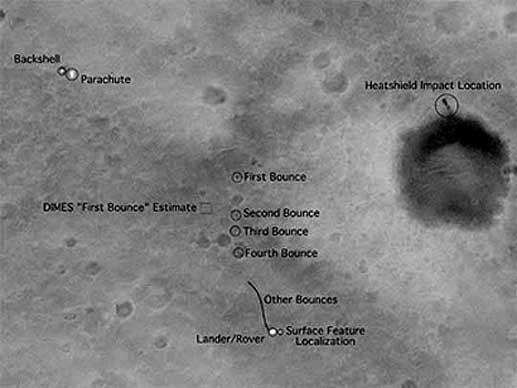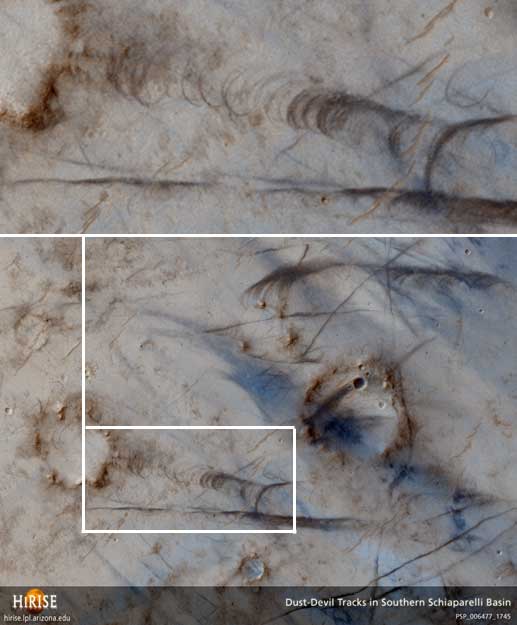
"Crop Circles on Mars"
DID STATIONARY DUST-DEVILS LEAVE 'CROP' CIRCLES IN MARTIAN SOIL?
by Andreas Müller, 2007-2008
Updated: January 24, 2008
LATEST NASA-IMAGES CONFIRM CIRCULAR DUST-DEVIL TRACES
...click HERE
This assumption might sound kind of far stretched on the first view, but the evidence may be in the images taken by NASA’s very own Mars-Rover „Spirit“.
In March 2005, NASA’s Mars-Rover „Spirit“ took the very first photos and (animated) footage of Martian dust-devils in action as they where twisting across the surface of the Gusev Crater where the mobile robot landed in in January 2004.
At that time of the year, even Mars celebrates hot summer temperatures that can rise up to 20°C (68°F) but fall during the night to a freezing low of -90°C (-130°F). Those warm daytime temperatures also can cause electrified Martian dust-devils – as captured by the robot’s cameras.
„Electrified dust devils“ – an expression you might also stumbled upon as „plasma vortex/vortices“ in crop circle terms. In fact crop circle research pioneer Terence Meaden wrote a whole chapter on “the properties of electrically-charged vortices” in his book “The Circle Effect and it’s Mysteries” (Artetech Publishing, Bradford-on-Avon, 1989)
>>> GET OUR FREE CROP CIRCLE NEWSLETTER HERE
The Martian dust devil documented on March 15, 2005, was spinning across the surface of Gusev Crater just before noon on Mars. NASA's Spirit rover took a series of images that were later assembled to a spectacular 21-frame animation with its navigation camera.
 Fig. 1: Dust devil crossing the surface of the Martian Gusev Crater on March 15, 2005. Click on the image to view the animated footage
Fig. 1: Dust devil crossing the surface of the Martian Gusev Crater on March 15, 2005. Click on the image to view the animated footage
Copyright: NASA
The event occurred during a period of 9 minutes and 35 seconds beginning at 11:48 a.m. local Mars time, recording the dust devil's progress in a northeasterly direction about 1.0 kilometer (0.62 mile) away from Spirit's perch on the slopes of the "Columbia Hills." The whirlwind was travelling at about 4.8 meters per second (16 feet per second) and covered a distance of about 1.6 kilometers (1 mile). The dust devil is about 34 meters (112 feet) in diameter.
After this event „Spirit“ was able to document several other smaller and bigger twisters in its direct surrounding. You can find a selection of these images and animated movies HERE.
As here on Earth, NASA’s science-site explains „dust-devils get their charge from grains of sand and dust rubbing together in the whirlwind. When certain pairs of unlike materials rub together, one material gives up some of its electrons (negative charges) to the other material. Such separation of electric charges is called triboelectric charging, the prefix "tribo" (pronounced TRY-bo) meaning "rubbing." Triboelectric charging makes your hair stand on end when you rub a balloon against your head. Dust and sand, like plastic and hair, form a tribolelectric pair. (Dust and sand aren't necessarily made of the same stuff (...) because dust can be blown in from anywhere.) Smaller dust particles tend to charge negative, taking away electrons from the larger sand grains.
Because the rising central column of hot air that powers the dust devil carries the negatively-charged dust upward and leaves the heavier positively-charged sand swirling near the base, the charges get separated, creating an electric field. On Earth, with instruments scientists have measured electric fields on the order of 20 thousand volts per meter (20 kV/m). That's peanuts compared to the electric fields in terrestrial thunderstorms, where lightning doesn't flash until electric fields get 100 times greater - enough to ionize (break apart) air molecules.
But a mere 20 kV/m would be very close to the breakdown of the thin Martian atmosphere. More significantly, Martian dust devils can be so much bigger than their terrestrial counterparts that their stored electrical energy may be much higher.“ So NASA scientists ask how would those fields discharge? Would one have Martian lightning inside the dust devils?"
Those fast moving whirl-winds are powerful enough, to leave clear tracks across the red Martian sandy and stony surface. This is where they have scoured away loose surface material to reveal the different-coloured soil beneath.
 Fig. 2: Dust devil tracks, photographed from orbit by „Mars Global Surveyor“ on Oct. 14, 2004. The tracks shown in this images are located in the southern Schiaparelli Basin near 5.3°S, 343.3°W. The image covers an area about 3 km (1.9 mi) across; sunlight illuminates the scene from the left/upper left.
Fig. 2: Dust devil tracks, photographed from orbit by „Mars Global Surveyor“ on Oct. 14, 2004. The tracks shown in this images are located in the southern Schiaparelli Basin near 5.3°S, 343.3°W. The image covers an area about 3 km (1.9 mi) across; sunlight illuminates the scene from the left/upper left.
Copyright: NASA
But what would happen, if such a Martian dust devil would form stationary and would not be chased over the terrain by local winds? Would it also express the above described properties and would it leave a „track“ on the ground?
So far there is no image that has been named officially to show such a spur left by a stationary Martian whirlwind - but some of „Sprits“ own shots might show it already. And it indeed looks kind of like a simple „crop circle“-like pattern in the Martian soil. In crop circle terms one would likely speak about a „single circle“ event with a possible second circle in the background.

Fig. 3: Image „PIA05108“ was taken by the panoramic camera onboard the „Mars Exploration Rover Spirit“ before it rolled off the lander and shows the rocky surface of Mars. Data from the camera's red, green and blue filters were combined to create this approximate true colour.
Copyright: NASA/JPL/Cornell

Fig. 4: A close-up of the above shown panoramic view focussing on the circular area. A second, likely similar circular „patch“ can be seen the background.
HERE you can view an interactive 180° panorama view
Take a close look at the inside area of the kind of cleared circular area and you can even see some spiral-like features in the ground, just as one would expect it to be the result of a spinning system on the loose surface of the Martian ground.
One possible alternative explanation for the circular area might be that it resembles one of the features interpreted by NASA to be surface disturbances caused by the bouncing (an estimated 28 times) of the airbag-cushioned rover as it moved up and down after first impact on Mars. The following satellite image shows “Spirit’s” landing site together with what had been interpreted as bounce-marks.
 Fig. 5: The “Spirit” landing site.
Fig. 5: The “Spirit” landing site.
Copyright: NASA
However, compared with ground images of known bounce-marks caused by “Spirit’s” sister-rover “Opportunity” in Meridiani Planum (below) it feels that the above discussed circular feature (Fig. 3, 4) is of a different quality and source.
 Fig. 6: Image taken by the camera of “Opportunity” of its own circular bounce-marks in the Martian surface at Meridiani Planum.
Fig. 6: Image taken by the camera of “Opportunity” of its own circular bounce-marks in the Martian surface at Meridiani Planum.
Copyright: NASA/JPL
Of course the above discussed circle-feature does not come close to the complex pattern “crop circles” have become famous for. However it might resemble “single circle events” – and if it is true that some genuine (not man-made crop circles) are (at least partially) the result of natural forces and phenomena, it would seem to be at least possible to find them as well on other planets similar to Earth. crop circles Further research into this subject of what could be called „Exo-Cereology“ is needed... If you have knowledge of other official images taken by NASA or ESA of the Martian surface that shows circular (or even more complex crop circle-like) features, we would be happy to learn more about it (...please contact the author).
UPDATE January 24, 2008
LATEST NASA-IMAGES CONFIRM CIRCULAR DUST-DEVIL TRACES
An image taken by the „High Resolution Imaging Science Experiment (HIRISE)“ of NASA’s „Mars Reconnaissance Orbiter“ on December 14, 2007 shows Dust-Devil Tracks in Southern Schiaparelli Basin.
The image confirms the ability of the dust devils vortex systems to create circular tracks in the Martian soil – even if (as in this case) not stationary but leaving a spiralled track.
 Fig. 7: Credit: NASA/JPL/University of Arizona
Fig. 7: Credit: NASA/JPL/University of Arizona
The original image (PSP_006477_1745) can be downloaded in different formats and sizes HERE
More Information on the image by NASA HERE
For further research like the above described project we need your support! By shopping at our new CropCircleShop you directly support ur work! Or make a donation here. Thank you!
